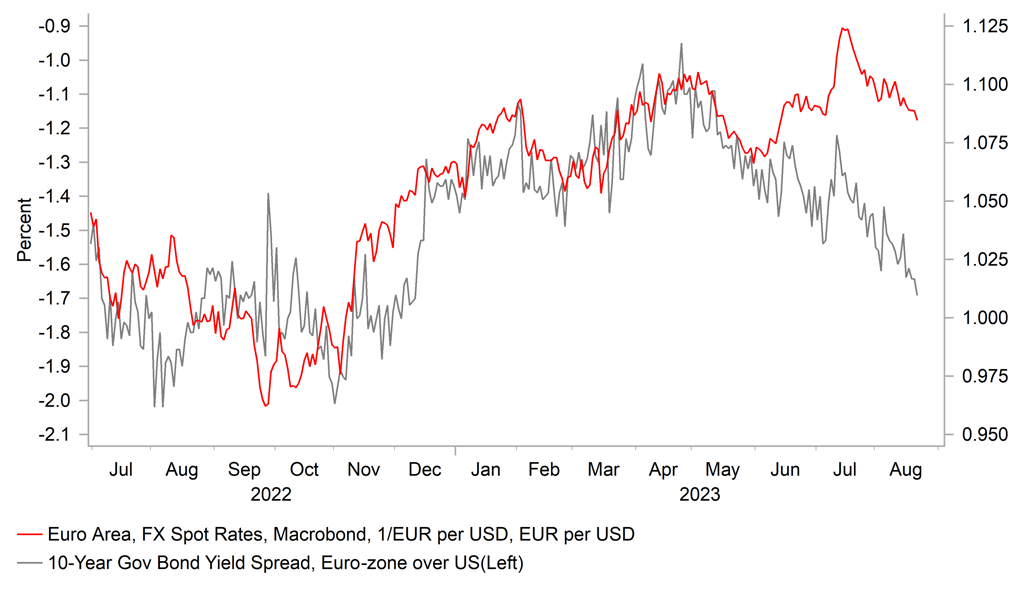USD remains on stronger footing ahead of Jackson Hole
NZD: Weak retail sales & China growth concerns in focus
The main foreign exchange rates have remained relatively stable during the Asian trading session with the dollar index continuing to trade close to recent highs around the 103.50-level. It is currently attempting to sustain a break back above the 200-day average that comes in at around 103.20 for the first time since November of last year. The main economic data release overnight has been the latest retail sales report from New Zealand that revealed a sharper than expected slowdown in spending in Q2. Sales adjusted for inflation and seasonal effects fell by -1.0% in Q2 which was more than twice as large as the drop expected by the consensus in the Bloomberg survey. It follows a downwardly revised contraction of -1.6% in Q1 and was the third consecutive quarter of negative growth. Today’s report continues to highlight that New Zealand’s economy remains in recession after GDP contracted for two consecutive quarters by -0.7% in Q4 2022 and by -0.1% in Q1 2023. Another mild contraction of -
0.1% is currently expected for Q2 as well. At last week’s RBNZ policy meeting, Governor Orr stated that a mild recession was the “bare minimum we to see because without doubt demand has been well outstripping the pace of the supply capacity” of the economy”. He wants to see subdued consumer spending, business investment and government constraints on spending. The main surprise though from a policy perspective was that the RBNZ has signalled that it plans to maintain tight policy for longer even as it becomes more evident that the economy is already in recession to help ensure that inflation falls back to target. The RBNZ expects the economy to continue contracting by -0.3% in Q3 and -0.1% in Q4. Despite the weak growth outlook, the RBNZ’s updated forecasts from last week signalled a higher risk of one more rate hike and that rate cuts aren’t likely for about 18 months.
The New Zealand dollar has failed to benefit from the RBNZ’s recent hawkish policy update. So far this month it has been the second worst performing G10 currency as both the Australian and New Zealand dollars have declined sharply by around -4.1% against the US dollar. It has resulted in the NZD/USD rate falling to a fresh year to date low of 0.5897 as it moves further below the recent peak of 0.6412 from 14th July. The recent sharp drop in the kiwi has attracted the attention of the RBNZ’s Chief Economist
Paul Conway who stated that they will be “mindful” of the depreciation going forward. He says the recent depreciation reflects a reduction in interest rate differentials and risk aversion. The New Zealand dollar has underperformed this month alongside other commodity-related currencies there has been more focus on the loss of growth momentum in China. RBNZ Chief Economist Conway stated that “if there was a more significant slowdown in China than the RBNZ expects, hurting exports and growth, “we would lower the OCR sooner than we have signalled”. Overall, the developments should reinforce the kiwi’s recent bearish trend.
YIELD SPREADS MOVING BACK IN USD’S FAVOUR

Source: Bloomberg, Macrobond & MUFG GMR
EUR/USD: PMI surveys and Payroll revisions in focus
The euro fell to a fresh low yesterday against the US dollar when it hit an intra-day low of 1.0833 with the pair moving closer to support from the 200-day moving average that comes in at around 1.0800. The euro has come under selling pressure against the US dollar over the past month as yield spreads have moved back in favour of the US, and there has been a clearer divergence between the cyclical performances of the eurozone and US economies. The 10-year yield spread between German and US government bonds was re-widened from around -1.4% at the start of July to closer to -1.7% as it moves back to levels that were in place towards the end of last year when EUR/USD was trading closer to parity than 1.1000. Economic data releases from the euro-zone have been surprising to the downside since May although have become less negative recently suggesting that the weaker outlook is now better priced in. Market participants will be watching closely today the release of the latest euro-zone PMI surveys for August to see if euro-zone economies have continued to lose growth momentum in Q3. Market participants have become less confident recently that the ECB will deliver another rate hike in September with around 16bps of hikes currently priced in for the 14th September policy meeting. The other main economic data release to watch out for today in the US will be the release of the 2023 Preliminary Benchmark Revision to Establishment Survey data. With the Fed at an important juncture in their tightening cycle and closing watching for evidence of slowing employment and wage growth, Fed policy expectations and the US dollar would prove sensitive if there are significant revisions to the employment data.
KEY RELEASES AND EVENTS
|
Country |
BST |
Indicator/Event |
Period |
Consensus |
Previous |
Mkt Moving |
|
EC |
09:00 |
Manufacturing PMI |
Aug |
42.6 |
42.7 |
!! |
|
EC |
09:00 |
Services PMI |
Aug |
50.5 |
50.9 |
!! |
|
UK |
09:30 |
Manufacturing PMI |
-- |
45.0 |
45.3 |
!!! |
|
UK |
09:30 |
Services PMI |
-- |
51.0 |
51.5 |
!!! |
|
CA |
13:30 |
Retail Sales (MoM) |
Jun |
0.0% |
0.2% |
!! |
|
US |
15:00 |
Payrolls Benchmark, n.s.a. |
-- |
-- |
506.00K |
! |
Source: Bloomberg


